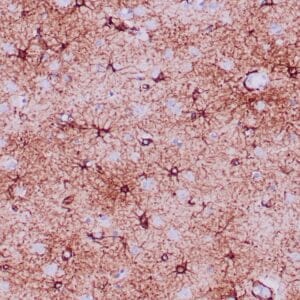| Weight | 1 lbs |
|---|---|
| Dimensions | 9 × 5 × 2 in |
| host | mouse |
| isotype | IgG1 |
| clonality | monoclonal |
| concentration | concentrate, predilute |
| applications | IHC |
| reactivity | human |
| available size | 0.1 mL, 0.5 mL, 1 mL concentrated, 7 mL prediluted |
mouse anti-GFAP monoclonal antibody GA-5 6194
Price range: $160.00 through $528.00
Antibody summary
- Mouse monoclonal to GFAP
- Suitable for: Immunohistochemistry (formalin-fixed, paraffin-embedded tissues)
- Reacts with: Human
- Isotype:IgG1
- Control: Brain or astrocytoma
- Visualization: Cytoplasmic
- 0.1, 0.5, 1.0 mL concentrated, 7 mL prediluted
mouse anti-GFAP monoclonal antibody GA-5 6194
| target relevance |
|---|
| Protein names Glial fibrillary acidic protein (GFAP) |
| Gene names GFAP,GFAP |
| Protein family Intermediate filament family |
| Mass 49880Da |
| Function FUNCTION: GFAP, a class-III intermediate filament, is a cell-specific marker that, during the development of the central nervous system, distinguishes astrocytes from other glial cells. |
| Subellular location SUBCELLULAR LOCATION: Cytoplasm {ECO:0000269|PubMed:12058025}. Note=Associated with intermediate filaments. {ECO:0000269|PubMed:12058025}. |
| Tissues TISSUE SPECIFICITY: Expressed in cells lacking fibronectin. {ECO:0000269|PubMed:1847665}. |
| Structure SUBUNIT: Interacts with SYNM. {ECO:0000250|UniProtKB:P03995}.; SUBUNIT: [Isoform 2]: Interacts with PSEN1 (via N-terminus). {ECO:0000269|PubMed:12058025}. |
| Post-translational modification PTM: Phosphorylated by PKN1. {ECO:0000269|PubMed:12686604, ECO:0000269|PubMed:9099667, ECO:0000269|PubMed:9175763}. |
| Involvement in disease DISEASE: Alexander disease (ALXDRD) [MIM:203450]: A rare disorder of the central nervous system. The most common form affects infants and young children, and is characterized by progressive failure of central myelination, usually leading to death within the first decade. Infants with Alexander disease develop a leukodystrophy with macrocephaly, seizures, and psychomotor retardation. Patients with juvenile or adult forms typically experience ataxia, bulbar signs and spasticity, and a more slowly progressive course. Histologically, Alexander disease is characterized by Rosenthal fibers, homogeneous eosinophilic inclusions in astrocytes. {ECO:0000269|PubMed:11138011, ECO:0000269|PubMed:11567214, ECO:0000269|PubMed:11595337, ECO:0000269|PubMed:12034785, ECO:0000269|PubMed:12034796, ECO:0000269|PubMed:12581808, ECO:0000269|PubMed:12944715, ECO:0000269|PubMed:12975300, ECO:0000269|PubMed:15030911, ECO:0000269|PubMed:15732097, ECO:0000269|PubMed:17043438, ECO:0000269|PubMed:17805552, ECO:0000269|PubMed:17894839, ECO:0000269|PubMed:17934883, ECO:0000269|PubMed:17960815, ECO:0000269|PubMed:18004641, ECO:0000269|PubMed:18079314, ECO:0000269|PubMed:19412928, ECO:0000269|PubMed:20359319, ECO:0000269|PubMed:21917775, ECO:0000269|PubMed:23364391, ECO:0000269|PubMed:23743246, ECO:0000269|PubMed:24742911}. Note=The disease is caused by variants affecting the gene represented in this entry. |
| Target Relevance information above includes information from UniProt accession: P14136 |
| The UniProt Consortium |
Data
 |
| Human brain stained with anti-GFAP antibody using peroxidase-conjugate and DAB chromogen. Note positive staining of astrocytic processes. |
Publications
| pmid | title | authors | citation |
|---|---|---|---|
| We haven't added any publications to our database yet. | |||
Protocols
| relevant to this product |
|---|
| IHC |
Documents
| # | SDS | Certificate | |
|---|---|---|---|
| Please enter your product and batch number here to retrieve product datasheet, SDS, and QC information. | |||
Only logged in customers who have purchased this product may leave a review.


Reviews
There are no reviews yet.